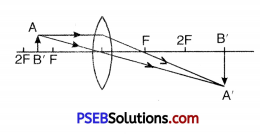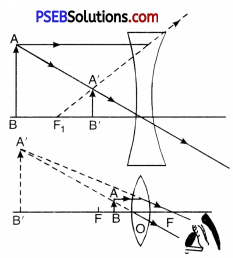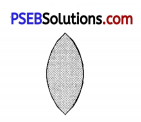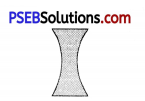Punjab State Board PSEB 7th Class Science Book Solutions Chapter 15 Light Textbook Exercise Questions and Answers.
PSEB Solutions for Class 7 Science Chapter 15 Light
Science Guide for Class 7 PSEB Light Intext Questions and Answers
Think and Answer (Textbook Page No. 186)
Question 1.
The process of change in direction of light after falling on a mirror is called ……………….. of light.
Answer:
Reflection.
Question 2.
Angle of incidence is equal to angle of reflection. (True/False)
Answer:
True.
![]()
Think and Answer (Textbook Page No. 189)
Question 1.
The distance between the object and the mirror is ……………… to the distance
between the image and the mirror.
Answer:
Equal.
Question 2.
Thes plane mirror has to be placed vertically on the graph paper. (True/False)
Answer:
True.
Question 3.
The plane mirror should be vertically upright.
Answer:
Right.
Think and Answer (Textbook Page No. 191)
Question 1.
The image of the sun formed by the concave mirror on the wall is …………………… image.
(Real/Virtual)
Answer:
Real.
Question 2.
Is the image of a candle seen using a concave mirror same as that the image of the Sun seen on the wall ?
Answer:
In both cases the rays of light are reflected from a concave mirror to form a real image.
Think and Answer (Textbook Page No. 192)
Question 1.
When the object is very far from the concave mirror, the image formed is ………………….
and
Answer:
Real, inverted/small in size.
Question 2.
The image formed on the screen is real.
Answer:
True. (True/False)
Question 3.
For a concave mirror, the image formed is always real.
Answer:
False.
![]()
Think and Answer (Textbook Page No. 195) (True/False)
Question 1.
The bright spot of light obtained on the paper is the image formed due to effect.
Answer:
Converging.
Question 2.
The image obtained on the paper is the virtual image.
Answer:
False.
Think and Answer (Textbook Page No. 196)
Question 1.
The convex lens is placed between the object and the screen. (True/False)
Answer:
True.
Question 2.
For a convex lens, the image formed is always real. (True/False)
Answer:
False.
Think and Answer (Textbook Page No. 198)
Question 1.
White light is composed of ………………. Colours. (True/False)
Answer:
Seven.
Question 2.
When disc with seven colours is rotated, it appears to be red. (True/False)
Answer:
False.
Question 3.
Name the seven colours of which the white light is made of.
Answer:
The seven colours of white light are:
- Violets,
- Indigo,
- Blue,
- Green,
- Yellow,
- Orange
- Red.
Collectively called VIBGYOR.
![]()
PSEB 7th Class Science Guide Light Textbook Questions and Answers
1. Fill in the Blanks:
(i) An image formed by a ………………….. mirror is always of the same size as that of object.
Answer:
plane
(ii) In a plane mirror, the left hand of a person appears to be the ………………… hand in the image and ……………. hand appears to be the left hand in the image.
Answer:
right, right
(iii) The image formed by a convex mirror is always ………………… and ……………….. in size.
Answer:
erect, smaller
(iv) Convex lenses are ………………… in the middle and concave lenses are ……………….. in the middle than at the edges.
Answer:
thin, thick
(v) A prism splits the white light into ……………….. colours.
Answer:
seven
2. State True or False:
(i) There is reflection of light through a lens.
Answer:
False
(ii) The ray of light coming towards the plane mirror is called the reflected ray.
Answer:
False
![]()
(iii) The image formed by a plane mirror is always in front of the mirror.
Answer:
False
(iv) A concave mirror is a part of hollow sphere of glass, whose outer side is coated with silver layer and reflection takes place from the inside.
Answer:
True
(v) Concave lens always forms a virtual, erect and smaller image of the object.
Answer:
True
3. Choose the Correct Answer:
Question (i)
Which of the following does not show reflection of light ?
(a) Plane mirror
(b) Concave mirror
(c) Convex mirror
(d) Card board.
Answer:
(d) Card board.
Question (ii)
Which is used for rear view in cars and other vehicles:
(a) Concave mirror
(b) Convex mirror
(c) Convex lens
(d) Concave lens.
Answer:
(b) Convex mirror.
Question (iii)
The image of an object formed by a concave lens is always ?
(a) Real and diminished
(b) Virtual and larger
(c) Real and larger
(d) Virtual and diminished.
Answer:
(d) Virtual and diminished.
Question (iv)
The process of splitting of white light in seven colours on passing through a prism is called:
(a) Reflection of light
(b) Refraction of light
(c) Bending of light
(d) Dispersion of light.
Answer:
(d) Dispersion of light.
![]()
4. Match the Column ‘I’ with Column ‘II’:
| Column ‘I’ | Column ‘II’ |
| 1. Mirror used by dentists | (a) Spectacles |
| 2. Rear view Mirror | (b) Microscope |
| 3. Magnifying glass | (c) Vehicles |
| 4. Concave Lens | (d) Concave |
Answer:
| Column ‘I’ | Column ‘II’ |
| 1. Mirror used by dentists | (d) Concave |
| 2. Rear view Mirror | (c) Vehicles |
| 3. Magnifying glass | (b) Microscope |
| 4. Concave Lens | (a) Spectacles. |
5. Very Short Answer Type Questions:
Question (i)
Is the image formed by a plane mirror real or virtual ?
Answer:
The image formed by the plane mirror is Virtual.
Question (ii)
Which lens forms a real image of an object ?
Answer:
Convex lens forms a real image of the object.
Question (iii)
Which optical instrument uses convex lens ?
Answer:
Convex lens is used in a microscope.
Question (iv)
What is the seven rainbow coloured disc called ?
Answer:
The seven-rainbow coloured disc is called Newton’s disc.
6. Short Answer Type Questions:
Question (i)
Differentiate between Real and Virtual images. Give examples.
Answer:
Difference between Real image and Virtual image:
| Real image | Virtual image |
| 1. The rays of light coming from the object are actually found to meet at a point after reflection or refraction. | 1. The light rays coming from an object do not actually meet but appear to meet at a single point after reflection or refraction. |
| 2. They are always inverted. | 2. They are always erect. |
| 3. Real image can be obtained on a screen.
Example : (a) If the object is too far away from the concave mirror, the image becomes too small and inverted. When the object is brought closer to the concave miiror, the image after reflection becomes large and real. (b) If the object is in front of a convex lens then the rays coming from that will form a real, inverted image after refraction. |
3. Virtual image can not be obtained on a screen
Example : (a) If the object is between the focal point of the concave mirror and the object, then the image is large, upright and virtual.In the convex mirror for each position of the object, the image obtained is virtual, erect and small. (b) If the object is between the focal point of the convex lens and the lens, then image is virtual, erect and large. |
![]()
Question (ii)
A person is standing 5m away from a plane mirror. How far will his image be:
(a) from the mirror
(b) from the person himself ?
Solution:
We know that the image formed in a plane mirror is at the same distance behind the mirror is as the object is in front of the mirror. So,
(a) Distance of image from the mirror = Distance of person from the mirror
= 2 meters
(b) Distance of the image from the person = Distance of the person from the plane mirror + Image distance from the mirror. = 2 meters + 2 meters
∴ Distance of the image from the person = 4 meters
Question (iii)
Give two uses of concave mirrors.
Answer:
Uses of concave mirrors:
- Concave mirror is used as a having mirror, as the concave mirror produces a large and erect image when the mirror is placed close to the face.
- Concave mirrors are mostly used on the headlights of vehicles. Here the bulb (light source) is placed on the principal focus of the concave mirror.
Question (iv)
State two differences between convex lens and concave lens.
Answer:
Difference between convex lens and concave lens:
| Convex lens | Concave lens |
| (1) It is thick in the middle and thin at the edges. | (1) It is thin in the middle and thick at the edges. |
| (2) It generally forms a large image of the object. | (2) It forms a small and virtual image of the object. |
Question (v)
Of how many colours is white light made of ? Name them.
Answer:
White light consists of seven colours. Their names are:
- Violet,
- Purple (Indigo),
- Blue,
- Green.
- Yellow,
- Orange and
- Red.
Question (vi)
Ravi is observing his image in a plane mirror. The distance between the mirror and his image is 6 m. If he moves 2 m towards the mirror, then the distance between Ravi and his image will be:
Answer:
Given, the distance between the plane mirror and the image = 6 meters
We know, the distance between the object (Ravi) and the mirror = Distance between the mirror and the image
Distance between Ravi and mirror = 6 meters (Given.)

When he moves 2 meters forward then the distance between Ravi and mirror will be
= 6 meters – 2 meters
= 4 meters.
Now,
Distance between Ravi and his image = Distance between Ravi and Plane mirror + Distance between plane mirror and image
= 4 meters + 4 meters
= 8 meters
7. Long Answer Type Questions:
Question (i)
State and explain the characteristics of the image formed by a plane mirror.
Answer:
Characteristics of the image formed by the plane mirror:
- The image of the burning candle (object) is seen behind the mirror at the same distance. Therefore the image formed by a plane mirror is always formed as far behind the mirror as the objects is in front of it.
- Since the image of the candle behind the mirror cannot be obtained on the screen, therefore, The image formed by the mirror is always virtual.
- When we place the candle upright the image formed is also upwards. This shows that the image formed by a plane mirror is erect.
- When we compare the size of the candle and its image formed in a plane mirror, they are of the same size. This shows the size of the object and the size image formed by the plane mirror is equal.
- The distance between the candle and the mirror is equal to the distance between the image of the candle and the minor.
- The image formed by a plane mirror is laterally inverted. That is, the left side of the object appears to the right side of the image and the right side of the object is to the left side of the image.
Question (ii)
What is meant by dispersion of the light ? Explain by using a Prism. Which natural phenomenon is associated with dispersion of light ?
Answer:
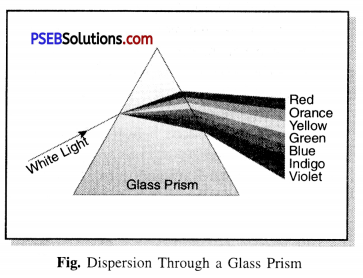
Dispersion of Light.
It is the phenomena of spliting the white light into its seven colours. The process of its separation into seven colors is characterized by a white ray of light passing through the prism as shown in the figure.
Place a white screen on the other side of prism. You will see that the white light will be splited in seven colors. These colors form a band of the seven colors received on the screen called the spectrum. Due to the different wavelengths of the seven colors, these seven colors diverge at different angles. These seven colors are: (1) Violet, (2) Indigo, (3) Blue, (4) Green, (5) Yellow, (6) Orange, (7) Red.
We can remember these names with the word VIBGYOR formed from their first letters. You may have seen rainbows forming in the sky after rain. It causes the rays of the sun’s white light to be dispersed from the water droplets hanging in the atmosphere. Here the water droplets act like a prism and split up the white sunlight into its seven colours.
![]()
PSEB Solutions for Class 7 Science Light Important Questions and Answers
1. Fill in the Blanks:
(i) An image that cannot be obtained on a screen is called …………………..
Answer:
virtual image
(ii) Image formed by a convex …………………. is always virtual and smaller in size.
Answer:
mirror
(iii) An image formed by a ………………….. mirror is always of same size as that of an object.
Answer:
plane
(iv) An image which can be obtained on a screen is called a ………………. image
Answer:
real
(v) An image formed by a …………………. lens cannot be obtained on a screen.
Answer:
concave
2. Match the Column ‘A’ with Column ‘B’:
| Column ‘A’ | Column ‘B’ |
| (i) Convex lens | (a) Rainbow |
| (ii) Real, inverted and equal image | (b) Concave mirror |
| (iii) Alphabetical process | (c) Magnifying glass |
| (iv) Virtual image | (d) Convex lens |
| (v) The reflecting surface is inward | (e) Cannot be obtained on screen |
Answer:
| Column ‘A’ | Column ‘B’ |
| (i) Convex lens | (c) Magnifying glass |
| (ii) Real, inverted and equal image | (d) Convex lens |
| (iii) Alphabetical process | (a) Rainbow |
| (iv) Virtual image | (e) Cannot be obtained on screen |
| (v) The reflecting surface is inward | (b) Concave mirror. |
3. Choose the Correct Answer:
Question (i)
Light travels in:
(a) Straight lines
(b) Curved lines
(c) Circles
(d) None of the above.
Answer:
(a) Straight lines.
![]()
Question (ii)
Erect, virtual and diminished image is formed in:
(a) plane mirror
(b) concave mirror convexo.
(c) convex mirror
(d) concave mirror
Answer:
(c) convex mirror.
Question (iii)
To see an object it is necessary:
(a) Source of light
(b) Source of light and an object
(c) Source of light, object and an eye
(d) None of these.
Answer:
(c) Source of light, object and an eye.
Question (iv)
After passing through a prism, light is split up into:
(a) two colours
(b) five colours
(c) seven colours
(d) six colours.
Answer:
(c) seven colours.
Question (v)
To see magnified view of teeth, dentists use:
(a) plane mirror
(b) concave mirror
(c) convex mirror and convex mirrors.
(d) combination of concave
Answer:
(b) concave mirror
Question (vi)
Which mirror is used to get magnified and real image ?
(a) convex mirror
(b) plane mirror
(c) concave mirror
(d) none of the above.
Answer:
(c) concave mirror.
Question (vii)
Convex lens is:
(a) thick at the centre and thin at the edges
(b) thick at the edges and thin at the centre
(c) uniformly thick
(d) irregularly thick.
Answer:
(a) thick at the centre and thin at the edges.
Question (viii)
When Newton disc is rotated fast which colour is seen ?
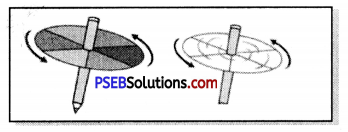
(a) Black
(b) White
(c) Blue
(d) Yellow.
Answer:
(b) White.
![]()
Very Short Answer Type Questions
Question 1.
Give one property of light.
Answer:
Light travels in a straight line.
Question 2.
Which surface acts as a mirror ?
Answer:
Any smooth and polished surface.
Question 3.
If you are standing in front of a plane mirror and observing your own image what is the relation
Answer:
Distance of the object from the mirror = Distance of the Image from the mirror.
Question 4.
What are spherical mirrors ?
Answer:
Spherical Mirrors. Spherical mirrors are the part of hollow spherical reflecting surface of which the mirror is a part. The spherical mirrors are of two types:
- Concave mirrors
- Convex mirrors.
Question 5.
One wants to get an enlarged image of an object in a mirror. What type of mirror should one use ?
Answer:
Concave mirror.
Question 6.
What type of mirror is used in automobiles for the benefit of drivers ?
Answer:
Convex mirror.
Question 7.
What type of mirrors are used in search-lights and head lights of cars ?
Answer:
Concave mirror.
![]()
Question 8.
Name the mirror in which the image of object is always diminished and virtual.
Answer:
Convex mirror.
Question 9.
Name the kind of mirror which produces a diminished real image.
Answer:
Concave mirror.
Question 10.
Write a note on convex lens.
Answer:
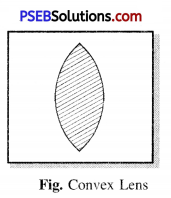
Convex lens.
A convex lens is thick in the centre and thin at the edges. This lens has the capability to converge a beam of light. So this lens is also called a converging lens.
Question 11.
What is a concave lens ?
Answer:
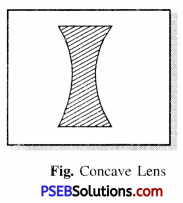
Concave lens.
A concave lens is thin at the centre and thick at the edges. This lens has a capacity to diverge a beam of light. So this lens is also called a diverging lens.
Question 12.
Name the seven constituent colors of light.
Answer:
Violet, Indigo, Blue, Green, Yellow, Orange, Red.
Question 13.
Describe a natural phenomenon in which seven colors of light are displayed.
Answer:
View of the rainbow after rains.
Short Answer Type Qucstions
Question 1.
Why should not we see towards sun through a convex lens ?
Answer:
A convex lens is a converging lens. It converges a beam of parallel rays coming from the Sun at the focus. If a piece of paper or cloth is placed at the focus of a convex lens from the sun, these catch fire. So, if we see towards the sun through a convex lens, large amount of heat will be produced which is very harmful for the eyes. Hence we should not see the sun through a convex lens.
Question 2.
What is a virtual image ? Give one situation where a virtual image is formed.
Answer:
Virtual image. An image which cannot be obtained on a screen, is called a virtual image.
Image formed in a plane mirror is always virtual.
Image in a concave mirror is virtual when object is placed very close to the mirror.
Image formed in a convex mirror is always virtual.
![]()
Question 3.
State two differences between a convex and a concave lens.
Answer:
Differences between a Convex and a Concave lens:
| Convex lens | Concave lens |
| 1. It is thick at the centre and thin at the edges.
|
It is thin at the centre and thick at the edges
|
| 2. The image is generally formed on the other side of the lens (except when the object is between F and optical centre). | The image is formed on the same side of the object. |
| 3. It converges a beam of light to a | It diverges a beam of light as coming from a point. |
Question 4.
Give one use each of a concave and a convex mirror.
Answer:
Use of concave mirror. It is used as reflector in a searchlight or car head-light.
Use of convex mirror. It is used in cars and other vehicles as a rear view mirror.
Question 5.
Which type of mirror can form a real image ?
Answer:
A concave mirror forms a real image.
Question 6.
Which type of lens forms always a virtual image ?
Answer:
Concave lens.
Question 7.
Give the conditions necessary for seeing an object.
Answer:
Conditions for seeing an object. To see an object the following three conditions are required to be satisfied:
- Source of light to make the object visible.
- The object.
- Eye.
Question 8.
What are the uses of mirrors ?
Answer:
Uses of Mirrors. We use mirrors in our daily life for one or the other purpose.
(i) Plane Mirror. Plane mirrors are used in the barber’s shops and in homes as looking glass. It is also used in periscope and other optical instruments.
(ii) Concave mirror.
- It is used as reflector in a search light or in a car head light.
- It is used in the solar cookers to converge the radiations coming from the sun.
(iii) Convex mirror.
- It is used in the cars and other vehicles as a rear view mirror to have look at the vehicles coming behind.
- It is used in amusement parks for showing strange looking images of people who stand in front of them.
Long Answer Type Question
Question 1.
Give an experiment to show that white light is made up of seven colours.
Answer:
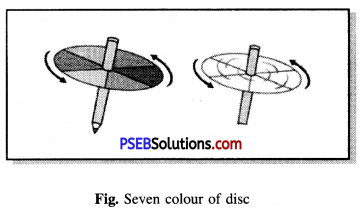
White light is a mixture of seven colours. To prove that white light is a mixture of seven colours, the following activity is performed.
Make a small top with a rotating disc. Paint the upper surface of the disc with sectorial area proportionately to the seven colours of the rainbow. Now rotate the disc when a white colour will appear on the disc. Light helps us to see the objects around us.

